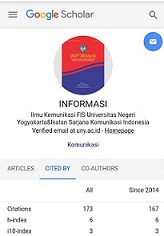Gemoy and Samsul: How The Propaganda Won The 2024 Indonesian Election
Raidah Intizar Yusuf, Universitas Islam Makassar
Pramudita Budi Rahayu, Universitas Islam Makassar
Abstract
This study aims to determine the forms of political buzzer propaganda ahead of the 2024 election on Twitter/X. The research method used is a qualitative approach using content analysis and the type of data used is secondary data in the form of tweets or uploads that themed the 2024 presidential election. The data was inputted manually using Microsoft Excel and then analyzed systematically using the SPSS 25 program. The chi square test result is < .001, which means that there are significant differences between candidates in the forms of propaganda. Tweets discussing Prabowo-Gibran were the most propaganda-laden which included name calling, transfer, testimonial, card stacking, and bandwagon, with the exception of plain folks, which is propaganda that shows the efforts of the presidential and vice presidential candidates' closeness to the public, in this category, candidate pair number three, namely Ganjar-Mahfud, is significantly higher than other candidate pairs, and gliterring generalities, namely propaganda with positive connotations on the presidential and vice presidential candidate pairs being discussed, in this case candidate pair number one Anies Imin is significantly higher than other pairs. Name-calling was the most significantly utilized in tweets discussing Prabowo-Gibran, compared to other form of propaganda in tweets discussing the other two candidate pairs. This highlighted the importance of spinning the unfavorable attributes to become a favorable one.
Keywords
Full Text:
PDFReferences
Aspinall, E., Fossati, D., Muhtadi, B., & Warburton, E. (2018, April 24). Mapping the Indonesian political spectrum. New Mandala. https://www.newmandala.org/mapping-indonesian-political-spectrum/
Banurea, O. K. (2023). Efektivitas Pengawasan Kampanye Berbasis Digital: Pencegahan Pelanggaran Praktek Kampanye Berbasis Digital). Mediation : Journal of Law, 59–77. https://doi.org/10.51178/mjol.v2i1.1356
Berelson, B. (1952). Content Analysis in Communication Research. Free Press.
Budiarto, G., Yuliati, D., & Puguh, D. R. (2021). Rising Sun in the Eastern Horizon of Java: The Occupation of Japanese 16th Army in Banyuwangi, East Java 1942-1945. E3S Web of Conferences, 317, 04013. https://doi.org/10.1051/e3sconf/202131704013
Dewantara, J. A., Syamsuri, S., Wandira, A., Afandi, A., Hartati, O., Cahya, N., Sapitri, P., & Nurgiansah, T. H. (2022). The Role of Buzzers in Social Media in Guiding Public Opinion Regarding Political Choices. JED (Jurnal Etika Demokrasi), 7(3), Article 3. https://doi.org/10.26618/jed.v7i3.8103
Dharma, F. A., Hariyanto, D., & Muharram, F. (2023). Construction of Political Identity on Instagram: Unveiling the Kadrun Hashtag Movement in Indonesia’s 2024 Presidential Election: Academia Open, 8(2), Article 2. https://doi.org/10.21070/acopen.8.2023.6922
Dina Wulandari, C., Muqsith, M., & Ayuningtyas, F. (2023). Fenomena Buzzer Di Media Sosial Jelang Pemilu 2024 Dalam Perspektif Komunikasi Politik. Avant Garde, 11, 134–147.
Firmansyah, M. A., Mulyana, D., Karlinah, S., & Sumartias, S. (2018). Kontestasi Pesan Politik dalam Kampanye Pilpres 2014 di Twitter: Dari Kultwit Hingga Twitwar. Jurnal Ilmu Komunikasi, 16(1), Article 1. https://doi.org/10.31315/jik.v16i1.2681
Hidayat, R. N. (2020). Penggunaan Buzzer Politik di Media Sosial Pada Masa Kampanya Pemilihan Umum. ADALAH, 4(2), Article 2. https://doi.org/10.15408/adalah.v4i2.15606
Mustika, R. (2019). PERGESERAN PERAN BUZZER KE DUNIA POLITIK DI MEDIA SOSIAL. Diakom : Jurnal Media Dan Komunikasi, 2(2), 144–151. https://doi.org/10.17933/diakom.v2i2.60
Nimmo, D. D. (1978). Political Communication and Public Opinion in America. Goodyear Publishing Company.
Putra, S. K., & Damanik, S. F. (2021). Hate Speech About Politics in Social Media. Talenta Conference Series: Local Wisdom, Social, and Arts (LWSA), 4(2), Article 2. https://doi.org/10.32734/lwsa.v4i2.1208
Rice, RE., & Atkin, CK. (2008). PUBLIC COMMUNICATION CAMPAIGNS: Theoretical Principles and Practical Applications. In Media Effects (3rd ed.). Routledge.
Saraswati, M. S. (2020). The political campaign industry and the rise of disinformation in Indonesia. In R. Tapsell & A. Sinpeng (Eds.), From Grassroots Activism to Disinformation: Social Media in Southeast Asia. ISEAS-Yusof Ishak Institute.
Sugiono, S. (2020). Fenomena Industri Buzzer Di Indonesia: Sebuah Kajian Ekonomi Politik Media. Communicatus: Jurnal Ilmu komunikasi, 4(1), 47–66. https://doi.org/10.15575/cjik.v4i1.7250
Sunarwan, W., & Surlia, S. P. (2021). STRATEGI PENCITRAAN POLITIK CAPRES JOKOWI MELALUI INSTAGRAM: SEBUAH ANALISIS KONTEN KUALITATIF. JURNAL EKONOMI, SOSIAL & HUMANIORA, 3(01), Article 01.
Ulfa, K., Purnomo, E. P., & Kasiwi, A. N. (2020). The Campaign Strategy of 2019 Presidential and Vice-Presidential Elections on Social Media. Society, 8(2), Article 2. https://doi.org/10.33019/society.v8i2.137
Umami, A. M., & Qindy, F. H. A. (2023). The Use of Buzzers by Political Parties Which Result in Black Campaign Practices in Indonesia. JISIP (Jurnal Ilmu Sosial Dan Pendidikan), 7(4), Article 4. https://doi.org/10.58258/jisip.v7i4.5853
Yuliati, D. (2012). MEWASPADAI PROPAGANDA MELALUI KAJIAN SEJARAH (STUDI ATAS SISTEM PROPAGANDA JEPANG DI JAWA 1942-1945). HUMANIKA, 15(9). https://doi.org/10.14710/humanika.15.9
Yusuf, R. I. (2023). Komunikasi Politik: Seni dan Teori. Deepublish.
DOI: https://doi.org/10.21831/informasi.v54i2.75464
Refbacks
- There are currently no refbacks.
Copyright (c) 2024 Aisyah Sam, Raidah Intizar Yusuf, Pramudita Budi Rahayu
Supervised by
Our Journal has been Indexed by:
Informasi by http://journal.uny.ac.id/index.php/informasi is licensed under a Creative Commons Attribution-NonCommercial 4.0 International License.














